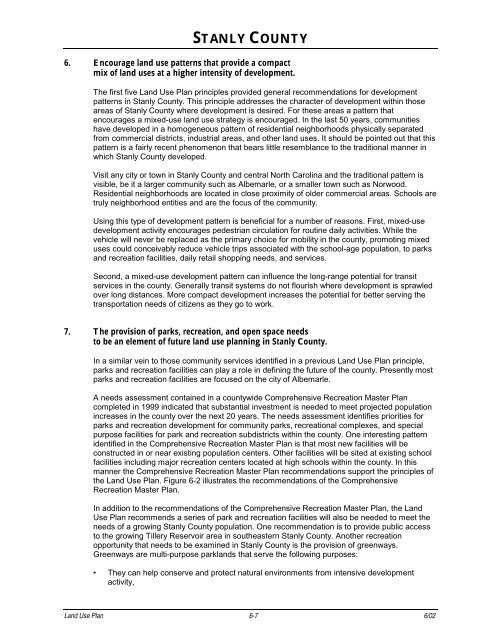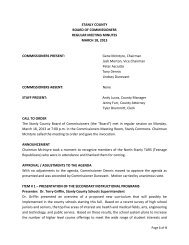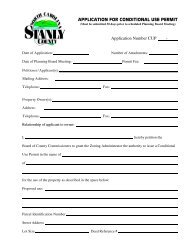Land Use Plan – 2002 - Stanly County, North Carolina
Land Use Plan – 2002 - Stanly County, North Carolina
Land Use Plan – 2002 - Stanly County, North Carolina
Create successful ePaper yourself
Turn your PDF publications into a flip-book with our unique Google optimized e-Paper software.
STANLY COUNTY<br />
6. Encourage land use patterns that provide a compact<br />
mix of land uses at a higher intensity of development.<br />
The first five <strong>Land</strong> <strong>Use</strong> <strong>Plan</strong> principles provided general recommendations for development<br />
patterns in <strong>Stanly</strong> <strong>County</strong>. This principle addresses the character of development within those<br />
areas of <strong>Stanly</strong> <strong>County</strong> where development is desired. For these areas a pattern that<br />
encourages a mixed-use land use strategy is encouraged. In the last 50 years, communities<br />
have developed in a homogeneous pattern of residential neighborhoods physically separated<br />
from commercial districts, industrial areas, and other land uses. It should be pointed out that this<br />
pattern is a fairly recent phenomenon that bears little resemblance to the traditional manner in<br />
which <strong>Stanly</strong> <strong>County</strong> developed.<br />
Visit any city or town in <strong>Stanly</strong> <strong>County</strong> and central <strong>North</strong> <strong>Carolina</strong> and the traditional pattern is<br />
visible, be it a larger community such as Albemarle, or a smaller town such as Norwood.<br />
Residential neighborhoods are located in close proximity of older commercial areas. Schools are<br />
truly neighborhood entities and are the focus of the community.<br />
Using this type of development pattern is beneficial for a number of reasons. First, mixed-use<br />
development activity encourages pedestrian circulation for routine daily activities. While the<br />
vehicle will never be replaced as the primary choice for mobility in the county, promoting mixed<br />
uses could conceivably reduce vehicle trips associated with the school-age population, to parks<br />
and recreation facilities, daily retail shopping needs, and services.<br />
Second, a mixed-use development pattern can influence the long-range potential for transit<br />
services in the county. Generally transit systems do not flourish where development is sprawled<br />
over long distances. More compact development increases the potential for better serving the<br />
transportation needs of citizens as they go to work.<br />
7. The provision of parks, recreation, and open space needs<br />
to be an element of future land use planning in <strong>Stanly</strong> <strong>County</strong>.<br />
In a similar vein to those community services identified in a previous <strong>Land</strong> <strong>Use</strong> <strong>Plan</strong> principle,<br />
parks and recreation facilities can play a role in defining the future of the county. Presently most<br />
parks and recreation facilities are focused on the city of Albemarle.<br />
A needs assessment contained in a countywide Comprehensive Recreation Master <strong>Plan</strong><br />
completed in 1999 indicated that substantial investment is needed to meet projected population<br />
increases in the county over the next 20 years. The needs assessment identifies priorities for<br />
parks and recreation development for community parks, recreational complexes, and special<br />
purpose facilities for park and recreation subdistricts within the county. One interesting pattern<br />
identified in the Comprehensive Recreation Master <strong>Plan</strong> is that most new facilities will be<br />
constructed in or near existing population centers. Other facilities will be sited at existing school<br />
facilities including major recreation centers located at high schools within the county. In this<br />
manner the Comprehensive Recreation Master <strong>Plan</strong> recommendations support the principles of<br />
the <strong>Land</strong> <strong>Use</strong> <strong>Plan</strong>. Figure 6-2 illustrates the recommendations of the Comprehensive<br />
Recreation Master <strong>Plan</strong>.<br />
In addition to the recommendations of the Comprehensive Recreation Master <strong>Plan</strong>, the <strong>Land</strong><br />
<strong>Use</strong> <strong>Plan</strong> recommends a series of park and recreation facilities will also be needed to meet the<br />
needs of a growing <strong>Stanly</strong> <strong>County</strong> population. One recommendation is to provide public access<br />
to the growing Tillery Reservoir area in southeastern <strong>Stanly</strong> <strong>County</strong>. Another recreation<br />
opportunity that needs to be examined in <strong>Stanly</strong> <strong>County</strong> is the provision of greenways.<br />
Greenways are multi-purpose parklands that serve the following purposes:<br />
They can help conserve and protect natural environments from intensive development<br />
activity,<br />
<strong>Land</strong> <strong>Use</strong> <strong>Plan</strong> 6-7 6/02






